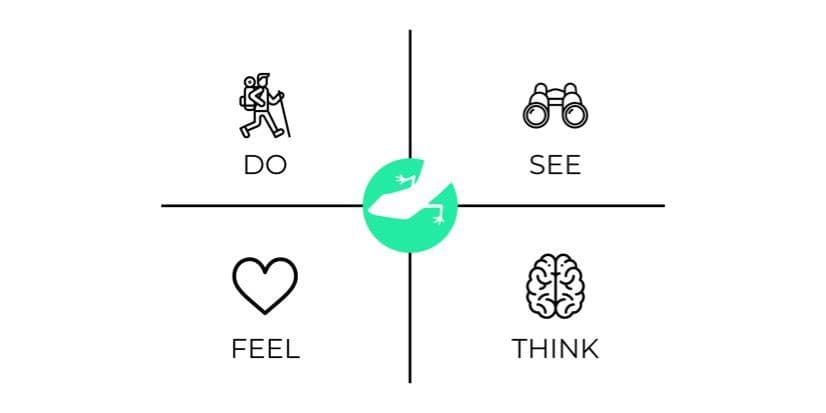target audience
customer personas
+ 4 more ...
Understanding Your Target Audience with Customer Personas
12 Aug 2020
by Lotte, Digital Content Specialist
12 Aug 2020
by Lotte, Digital Content Specialist
target audience
customer personas
empathy
human-centered
design thinking
end-users
Understanding Your Target Audience with Customer Personas
Table of contents
Contact us
We will get back to you in the next 48 hours.

Finding the right target audience isn’t a piece of cake. Creating customer personas can help you with this complex task.
As an entrepreneur it is crucial to know exactly who your customers are. However, finding the right target audience for your product or service can be quite the hassle. Many entrepreneurs struggle with the initial definition of the right target audience for their business, as well as the retention of the right audience. Markets change, your business changes, and it might just be that your target audience shifts along with those changes. In this blog, we provide you with some essential insights into targeting the right audience for your business with customer personas.
Customer personas
Whereas a target audience consists of a larger segment of customers that represent your audience, so-called customer personas represent one single customer to create a better understanding of the homogenous target groups and their core characteristics. Customer personas are detailed descriptions of fictional characters that represent different types of customers, based on the analysis of real customers. Customer personas are focused on “why” they act in certain ways, rather than “how” they act. The best ways to get deeper insights into who your customers are and why they make certain choices is by personalized surveys and one-to-one interviews with your customers. The creation of customer personas requires a long list of detailed descriptions about personal matters like, for example, their interests, lifestyle, motivations, ambitions, and other aspects that may impact the way they interact with your business.
The more information, the more detailed you can describe your individual target customers. Personas aren’t only useful for creating human-centred business strategies, they are also critical in the process of branding and how you showcase your business to the outside world in a way that suits your customers thinking.
But why should you focus so much on the individual customer while you’re aiming to target a much bigger group of people? Knowing your target audience in detail brings you closer to your customers. A deeper understanding of your individual customers makes it easier for you to create business strategies that are tailored to your target audience and its different characters. While gathering data about your customers is pretty straightforward, actually stepping into the shoes of your customers often proves quite difficult for businesses. An frequently used human-centred methodology of understanding your target audience is empathy mapping, which follows the principles of design thinking and aims to help businesses visualise what their customers are hearing, seeing, thinking and feeling. Most businesses use empathy mapping templates to create a basic image of their customer personas. Often, these templates are divided into four categories:
- What does the customer do?
- What does the customer see?
- What does the customer think?
- How does the customer feel?
</p>

The image above showcases a typical empathy mapping template, dividing the customer persona into the four categories, which are up to you to fill in according to the data and feedback you have collected from your customers. With these four basic questions, you create a framework of the persona you’ll develop in detail later on.
Creating customer personas
Creating a customer persona is an extensive process which requires a lot of details, but will provide you with a much better understanding of your customers in the end, which makes the effort worthwhile. Here’s a step-by-step guide to help you start your journey of customer persona creation:
1. Analyze profile data
The best way to start creating customer personas is by analyzing the data you already have. This data can be collected through analytical tools like Google Analytics, or via your social media channels, like Facebook Insights. With the collected data, you can take a look at who interacts with the content you post on your website or social media channels. What types of users usually like, comment or share your content? Can you already see similarities or differences between the people who interact with your content?
2. Seek customer input and feedback
Besides focussing on factual data, it is important to know “why” customers interact with your content. The best way to find an answer to this question is by personally interacting with your customers with surveys and one-to-one interviews. Surveys give you an insight into the individual customers and the motivations behind the choices they make and make it easier to create detailed customer personas.
3. Empathy mapping
Besides the direct input from individual customers, creating customer personas also requires your own input and interpretations. With empathy mapping you can gather the input from different customers and try to find similarities on which you can base one single fictional character. Empathy mapping serves as a template for creating these personas, based on the information you’ve gathered, combined with your own interpretations of these characters. Take a look again at the template shown before to see what categories form the core of empathy mapping.
4. Write a persona narrative
Once the basis is there, you can start broadening your persona with an underlying narrative or background story. After all, the more detailed your persona, the better the understanding of your customers, and the better you can focus your future strategies on the motivations and interests of your customers.
5. Add visual elements
You can add visual elements to the character persona you’ve created to simplify empathizing with your customers. Including a picture of your character helps you visualize the persona in more detail. And again, the more details, the better. You can use any kind of stock photo or, if you’re up to it, sketch a visualisation of your character.
When you’ve created and defined a few customer personas with their individual characteristics, it’s important to know how to use this information to benefit from it. So, what can you do with this information? Once you have created a deeper insight into the detailed characteristics of your customers, you can apply this information to your business and branding strategies. For example, if you know where your customers spend their time online, you can focus your marketing strategies on specific social media channels. Or if you’ve gained a deeper insight into their preferred use of communication, with for example emoji’s or hashtags, you can optimize your customer services by adapting to these preferences. Customer personas can also help you get an insight into what content they prefer to read, and allows you to create persona-specific blogs or other kinds of content.
Customer profiles
Besides customer personas, you can also use customer profiles to gain a deeper understanding of your target audience. A key difference between customer personas and customer profiles is the aspect of interpretation. Whereas customer personas are based on a fictional interpretation of your customers’ personalities, customer profiles are generally focused on what the customer does, rather than why they do it. Customer personas generally have a qualitative nature, whereas customer profiles are more quantitative. Profiles focus much more on factual demographics like age, income, education, geographical location, etc. Usually, you can find this factual data in Google Analytics, or on statistics pages of your business’ social media channels.
Customer profiles are often used to identify new prospects by understanding the profiles of your already existing customers. With this information, you can begin to look for similar profiles and access a larger pool of customers. Generally, customer personas are used to improve direct communication with your customers and inform your team about specific motivations behind the actions of your customers and steer your business strategies towards these motivations. User profiles are mostly used for targeting large-scale marketing campaigns, finding new prospects, and understanding the value of certain segments of your target audience.
Need help?
At Lizard Global, we deliver a complete all-in-one package of services to make sure your product reaches the success it deserves. Finding the right target audience is part of this package, and we gladly give you a hand in defining the customers that fit your business and products. So, if you’re stuck with finding the right target audience, don’t hesitate to get in touch with us!

Finding the right target audience isn’t a piece of cake. Creating customer personas can help you with this complex task.
As an entrepreneur it is crucial to know exactly who your customers are. However, finding the right target audience for your product or service can be quite the hassle. Many entrepreneurs struggle with the initial definition of the right target audience for their business, as well as the retention of the right audience. Markets change, your business changes, and it might just be that your target audience shifts along with those changes. In this blog, we provide you with some essential insights into targeting the right audience for your business with customer personas.
Customer personas
Whereas a target audience consists of a larger segment of customers that represent your audience, so-called customer personas represent one single customer to create a better understanding of the homogenous target groups and their core characteristics. Customer personas are detailed descriptions of fictional characters that represent different types of customers, based on the analysis of real customers. Customer personas are focused on “why” they act in certain ways, rather than “how” they act. The best ways to get deeper insights into who your customers are and why they make certain choices is by personalized surveys and one-to-one interviews with your customers. The creation of customer personas requires a long list of detailed descriptions about personal matters like, for example, their interests, lifestyle, motivations, ambitions, and other aspects that may impact the way they interact with your business.
The more information, the more detailed you can describe your individual target customers. Personas aren’t only useful for creating human-centred business strategies, they are also critical in the process of branding and how you showcase your business to the outside world in a way that suits your customers thinking.
But why should you focus so much on the individual customer while you’re aiming to target a much bigger group of people? Knowing your target audience in detail brings you closer to your customers. A deeper understanding of your individual customers makes it easier for you to create business strategies that are tailored to your target audience and its different characters. While gathering data about your customers is pretty straightforward, actually stepping into the shoes of your customers often proves quite difficult for businesses. An frequently used human-centred methodology of understanding your target audience is empathy mapping, which follows the principles of design thinking and aims to help businesses visualise what their customers are hearing, seeing, thinking and feeling. Most businesses use empathy mapping templates to create a basic image of their customer personas. Often, these templates are divided into four categories:
- What does the customer do?
- What does the customer see?
- What does the customer think?
- How does the customer feel?
</p>

The image above showcases a typical empathy mapping template, dividing the customer persona into the four categories, which are up to you to fill in according to the data and feedback you have collected from your customers. With these four basic questions, you create a framework of the persona you’ll develop in detail later on.
Creating customer personas
Creating a customer persona is an extensive process which requires a lot of details, but will provide you with a much better understanding of your customers in the end, which makes the effort worthwhile. Here’s a step-by-step guide to help you start your journey of customer persona creation:
1. Analyze profile data
The best way to start creating customer personas is by analyzing the data you already have. This data can be collected through analytical tools like Google Analytics, or via your social media channels, like Facebook Insights. With the collected data, you can take a look at who interacts with the content you post on your website or social media channels. What types of users usually like, comment or share your content? Can you already see similarities or differences between the people who interact with your content?
2. Seek customer input and feedback
Besides focussing on factual data, it is important to know “why” customers interact with your content. The best way to find an answer to this question is by personally interacting with your customers with surveys and one-to-one interviews. Surveys give you an insight into the individual customers and the motivations behind the choices they make and make it easier to create detailed customer personas.
3. Empathy mapping
Besides the direct input from individual customers, creating customer personas also requires your own input and interpretations. With empathy mapping you can gather the input from different customers and try to find similarities on which you can base one single fictional character. Empathy mapping serves as a template for creating these personas, based on the information you’ve gathered, combined with your own interpretations of these characters. Take a look again at the template shown before to see what categories form the core of empathy mapping.
4. Write a persona narrative
Once the basis is there, you can start broadening your persona with an underlying narrative or background story. After all, the more detailed your persona, the better the understanding of your customers, and the better you can focus your future strategies on the motivations and interests of your customers.
5. Add visual elements
You can add visual elements to the character persona you’ve created to simplify empathizing with your customers. Including a picture of your character helps you visualize the persona in more detail. And again, the more details, the better. You can use any kind of stock photo or, if you’re up to it, sketch a visualisation of your character.
When you’ve created and defined a few customer personas with their individual characteristics, it’s important to know how to use this information to benefit from it. So, what can you do with this information? Once you have created a deeper insight into the detailed characteristics of your customers, you can apply this information to your business and branding strategies. For example, if you know where your customers spend their time online, you can focus your marketing strategies on specific social media channels. Or if you’ve gained a deeper insight into their preferred use of communication, with for example emoji’s or hashtags, you can optimize your customer services by adapting to these preferences. Customer personas can also help you get an insight into what content they prefer to read, and allows you to create persona-specific blogs or other kinds of content.
Customer profiles
Besides customer personas, you can also use customer profiles to gain a deeper understanding of your target audience. A key difference between customer personas and customer profiles is the aspect of interpretation. Whereas customer personas are based on a fictional interpretation of your customers’ personalities, customer profiles are generally focused on what the customer does, rather than why they do it. Customer personas generally have a qualitative nature, whereas customer profiles are more quantitative. Profiles focus much more on factual demographics like age, income, education, geographical location, etc. Usually, you can find this factual data in Google Analytics, or on statistics pages of your business’ social media channels.
Customer profiles are often used to identify new prospects by understanding the profiles of your already existing customers. With this information, you can begin to look for similar profiles and access a larger pool of customers. Generally, customer personas are used to improve direct communication with your customers and inform your team about specific motivations behind the actions of your customers and steer your business strategies towards these motivations. User profiles are mostly used for targeting large-scale marketing campaigns, finding new prospects, and understanding the value of certain segments of your target audience.
Need help?
At Lizard Global, we deliver a complete all-in-one package of services to make sure your product reaches the success it deserves. Finding the right target audience is part of this package, and we gladly give you a hand in defining the customers that fit your business and products. So, if you’re stuck with finding the right target audience, don’t hesitate to get in touch with us!
similar reads

Workshops
Understanding Your Users With Our Design Thinking Workshop
22 February 2023

Agile
Lean & Scrum
Design Thinking
Understanding Your Target Audience with Customer Personas
21 February 2023

Agile
Lean & Scrum
Design Thinking
Software Development
The Road Towards Successful User Story Mapping
21 February 2023




